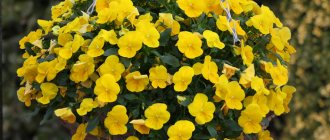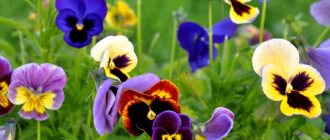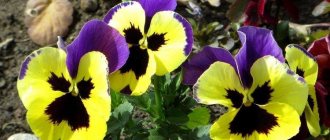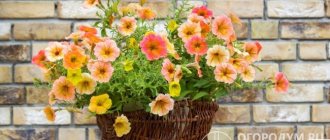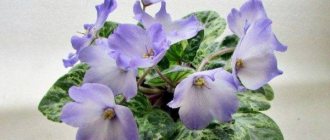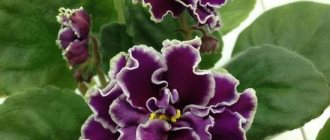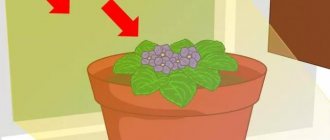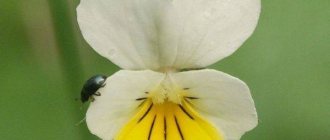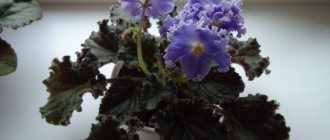There are many different types of flowers that resemble violets. They are sometimes called garden violets because they can grow outside of indoor conditions. Landscape designers often use them to decorate flower beds or garden paths. This type of plant is now very popular among gardeners. Among the flowers similar to violets are: primrose, Turkish carnation, petunia and many others, which are varied in care, but are similar to this delicate, homely flower.
Primrose
A perennial flower similar to a violet that begins to bloom immediately after the snow melts. The flowering process in good weather conditions lasts until the end of May. And although the plant resembles a violet, it is a small bush up to 30 cm in height, and the flowers are single and resemble the shape of an umbrella.
Color variety: blue, pink, lilac. Primrose also has more than 500 different species.
Reference. Primrose can be planted in any climatic conditions; it takes root well in any soil. It does not require abundant watering; it can additionally be fertilized with mineral supplements.
Everything about caring for and growing the Primrose plant at home.
Threats and pests
The first problems gardeners have with growing pansies may be due to the fact that planting in the ground was done incorrectly. The consequences may be as follows:
The seeds did not germinate. This may be due to the fact that the seeds themselves were not of very good quality. But it could also be that the soil was too dense and the seeds were planted too deep.
The sprouts are too weak. The reason may be that the seeds were planted too close to each other. Or perhaps they lacked important conditions for growth, such as light or beneficial minerals (most often nitrogen).
Growing pansies can be marred by the occurrence of various pests. Most often, flowers can be spoiled:
- gray rot: brown spots appear on the leaves, this may be a consequence of excessive watering
- powdery mildew: large light spots appear on the leaves, this may be a consequence of excessive fertilizing with nitrogen
- black leg: a dark area forms around the stem, which gradually destroys it - this may be a consequence of excessively heavy soil
- garden slugs: pests gradually eat leaves and flowers - to prevent their appearance it is necessary to mulch the soil
- aphids: pests feed on the sap of the stem and thin it - you can get rid of them with the help of insecticides
Pansy seedlings can become a perennial addition to any garden. They get along well in flower beds not only with representatives of the Violet family, but also with such beloved plants as daffodils, tulips and irises.
Using a variety of types and colors of pansies, you can create a unique landscape design in any area.
Achimenes
Indoor flowers called Achimenes can bloom 2-3 times a year. The buds bloom quickly and delight with long-lasting flowering. The plant, which resembles a violet with its flowers, is very unpretentious in maintenance, but needs sufficiently humidified air. And flowers react to temperature changes.
[adsp-pro-4]
This plant is popular because anyone can grow it at home. Achimenes dot and blueberry ripple are considered the most similar to violets. The color variety is very wide, bright colors, with a beautiful transition from light to darker shades.
Learn more about growing Achimenes at home.
Growing primroses in open ground
Despite the differences in origin and growing conditions, all types of flowers have enviable endurance, unpretentiousness and winter hardiness. Even in the harshest latitudes, they practically do not freeze out and maintain excellent shape with minimal care.
Selecting a location
In the wild, primroses grow in moist, shady places and, with rare exceptions, do not tolerate open spaces under the scorching sun. And since the ancestral memory remains in each plant, when choosing a place for planting, they are guided by appropriate considerations. The area should be shaded at least several hours a day.
They grow successfully under the arch of fruit trees, in mixborders or flower beds illuminated by the sun in the morning or late afternoon, adjacent to selected shade-tolerant crops such as daffodils, scylla, muscari, phlox, and low irises. In rock gardens, primroses are planted on the northern and eastern slopes.
Soil preparation and planting
The best soils for primroses are loose, fertile, breathable loams that retain moisture.
Important! Success in outdoor growing is maintaining a high degree of moisture in well-drained soil. Flower beds are arranged on a slight elevation, since high flower beds dry out faster
Planted young plants should not experience a lack of water, especially during the period of increased activity - budding. The soil consisting of heavy clays is lightened by adding sand, vermiculite or crushed sphagnum (1 bucket/1 m2) and fertilized by adding 20 kg of humus per 1 m2 and 50 g of complex mineral fertilizers.
Feeding
Specimens of spring flowering begin to grow very early, so the first fertilizing with a solution of complete mineral fertilizer (Kemira) is carried out along the thawed patch formed around the rosette. Instead of mineral fertilizing, you can use a 0.01 percent warm solution of Humate.
After 2 weeks, the plant is fed a second time - superfostat is added in an amount of 20 g / 1 m2. This will ensure lush flowering.
2-3 weeks after the end of flowering, the plant begins to lay flower buds, and to make the process more fruitful, the flower is fertilized with an infusion of fermented manure with a concentration of 1/10 liter, giving 1 liter for each rosette.
To ensure a comfortable wintering at the end of summer, primroses are fed with a solution of phosphorus-potassium fertilizers (30 g/10 l).
Advice! Watch the color of the leaves. It is an indicator of the condition of the plant. The bright, juicy greenery of the rosette throughout the entire growing season is an indicator of proper care and nutrition.
Watering
The moisture-loving primrose requires special attention in the spring: the soil must be constantly moistened, this is especially true if the spring turned out to be dry. A normal level of humidity should also be maintained in the summer by periodically watering the plant. By autumn, watering is stopped, since it should enter winter with dry soil.
Reproduction and transplantation
In addition to growing from seeds, primrose can be propagated by dividing the bush.
This is the most popular method. In addition, the plant is remarkable in that it tolerates this procedure painlessly even when it is blooming.
It is recommended not to keep the crop in one place for more than 5-6 years: the bush ages, and the flowers become noticeably smaller. The best time for transplantation is the first half of August. The bushes transplanted at this time will have time to take root and develop a root system before the onset of cold weather.
When replanting, the primrose is carefully dug out along with a lump of earth, divided, if necessary, into daughter rosettes, and planted in previously prepared and watered holes. The soil around the plant is compacted and watered again.
Turkish clove
Gardeners love Turkish cloves for their brightness and unpretentiousness. There are low-growing plants that resemble violets, as they reach a height of 15-20 cm. And there are tall plants, more than 80 cm in height. Turkish carnation can also be planted in the garden. The big disadvantage of these flowers is that they are highly susceptible to pests.
The bright, variegated colors of the plant always attract attention.
This plant requires careful care, namely:
- weed removal;
- frequent loosening of the soil;
- frequent watering;
- fertilizer;
- protection from pests.
Description
Viola flowers are perennial or annual, resembling violets in appearance. Pansies may be called tricolor violet or viola. Translated from Latin, viola means “blue.” Common names:
- Anyutka;
- Brother and sister;
- Moths;
- Three-flowered;
- Half color.
Pansies symbolize wisdom, loyalty and devotion. They are a symbol of spring, as they bloom very early.
Pansies are popularly called the flower of the Holy Trinity. The dark core represents the all-seeing eye, the diverging rays represent radiance. The peaks symbolize the three faces of the Holy Trinity. In the old days, girls crocheted flower patterns.
The plant was brought from Central China and Japan. Thanks to its bright and unusual appearance, it quickly gained popularity among gardeners. The name of the flower has changed over time. In Russia, the flower was called “Trinity Flower” for a long time. The official name “Pansy” was assigned to the tricolor violet in the Encyclopedic Dictionary, which was compiled by Russian scientists in the period from 1861 to 1863.
The flower is grown in the southern regions, but breeders have obtained varieties that allow the plant to be grown in central Russia, the Moscow region and the Urals.
Pansies
The flowering period begins in early April and ends at the end of summer. Description:
- The plant is annual or perennial;
- Flower diameter – from 5 to 10 mm;
- They have a light delicate aroma;
- Flowers can look different and come in several shades: purple, blue, white, yellow. Petals may differ in color: monotonous, double, petals with bright spots and stripes;
- Pansies vary in flower size, depending on the variety. There are small, large or giant flowers.
According to the height of the bush, viola is divided into:
- short;
- Average;
- Tall.
Viola can be called a universal plant for garden decoration. There are more than 15 main varieties of viola. The bushes grow up to 15-20 cm in height. The plant will quickly grow by self-sowing, forming beautiful flower beds with lush, bright flowers. The roots are deepened into the soil by 20 cm, the leaves are delicate green. Flowers are propagated by seeds and cuttings. The plant is grown for decorative purposes to decorate cottage villages, garden plots, and gazebos.
The flowering period begins in early April
Pansies
Most often, this plant is grown as a biennial. They bloom in the spring, the first year. Gardeners call them violets if the plant grew in the wild. It is low-growing, and the flowers are completely similar to violets, but much larger in size.
[adsp-pro-5]
In the summer, pansies can be grown in large pots on the balcony of the house. The plant requires careful watering and bright lighting. Gardeners recommend using mineral fertilizers, which will also affect the color and brightness of flowers.
Read about how to grow pansy flowers from seeds.
Growing flowers from seeds
Pansy seeds should be planted during the cooler months of the year - ideally in winter. The seeds are pre-treated, they are soaked in a special stimulating solution for a day, and then dried.
You need to plant the seeds in a shallow box at a distance of 1 centimeter from each other, sprinkle them with a little soil and cover them with film. You need to water the seeds drip-wise so as not to accidentally wash them.
The first shoots can be seen within a few weeks, but seedlings suitable for transplanting into the ground will appear no earlier than two to three months later.
Pansies should be planted in the ground before the last spring frost. This flower tolerates cold quite well, the main thing is to pay enough attention to its fertilization. For comfortable transplantation of seedlings, it is necessary to prepare holes fertilized with phosphorus and nitrogen.
Gloxinia
Flowers in pots, whose name is Gloxinia, are considered very sophisticated and special. And although they have similarities with violets, the stem of gloxinia is much thicker and stronger. The flowers reach a diameter of up to 7 cm, and the plant itself requires a lot of space and light.
There are several conditions under which the plant will take root and bloom for a long time:
- Fertilizing with nitrogen-free fertilizers.
- Large pot size.
- To ensure flowering lasts all year round, you need to build an insulated rack and additional lighting.
Find out more about caring for and growing Gloxinia at home.
Viola tricolor
Violet tricolor is a herbaceous plant, mostly growing wild. It is found in ravines, ditches, and meadows with acidic or neutral soil. Viola tricolor is often called wild pansy.
The plant forms small bushes, up to 15 cm high. The leaves are round, pointed at the end, collected in a rosette at the base of the bush. Peduncles with small flowers (up to 1.5 cm in diameter) at the ends rise from the rosette. The color of the flowers includes several shades: white, yellow, blue, purple.
Tricolor violet is unpretentious and can grow on poor, unfertilized soils.
Viola tricolor is considered an annual or biennial plant, although in fact it can “live” much longer, somewhat losing its decorativeness (this applies to almost all violas). Flowering - from April to September.
Tricolor violet is not only an ornamental plant, but also a medicinal plant. Used in dried form on its own or as part of herbal preparations.
Tricolor violet is a flower suitable for decorating a garden in a natural, natural style.
Petunia
And although petunia looks like a violet with its flowers, it is a large, growing bush. Its leaves are small in size, and the bush itself can be tall or short. The flowers are solitary and can come in more than 20 different colors. At the same time, they can be monochromatic or combine 2 or more colors.
Reference. Gardeners warn: to grow petunia, the soil must be neutral and loose, and sand can be used when sowing.
Read how to grow a real garden decoration - Petunia.
Landing
After purchasing an indoor primrose from a flower shop, it needs to be transplanted into a suitable pot. It is advisable to purchase a small container with drainage holes. You can prepare the soil mixture yourself by mixing peat, steamed sand and leaf soil in equal parts. When growing reverse conical primrose, it is advisable to add 1 part of turf to the soil.
Ready-made soil mixture can also be purchased at a flower shop. To grow this plant, nutrient soil intended for primroses and violets is suitable. Before pouring soil into the selected pot, you should place a layer of drainage on the bottom of the container.
Centopoly
Centopoly or indoor violet. The fringed centopoly has gained popularity among gardeners. It is sometimes called curly. The edge of the violet is white at the right temperature. And the colors of the plant are very diverse: from light pink to dark purple. The color is also affected by the quality of the soil.
[adsp-pro-6]
You can use mineral fertilizers, which also affect the color of the plant. Centopoly needs good lighting and does not tolerate temperature changes.
Location and temperature
The rules for caring for and growing primrose are quite simple. The plant tolerates cold and poorly bright sunlight. Therefore, it is better to place the pot with it on the north or west window. If this is not possible, then the flower is placed on the eastern windowsill and shaded.
As for the temperature regime, it is advisable to maintain the temperature at 12 - 16°C. In warmer climates, flowers begin to wilt and fall off. Try to avoid temperature changes during the flowering period.
Deikun
The plant, called Deikun, is also called Cinderella's Dream. An unusually beautiful plant, usually with white flowers, which may be slightly tinted in a different color. At the same time, the flowers are not very large, the maximum size is 4 cm. In good conditions, the plant blooms very often and with many buds.
Gardeners warn that not everyone can grow deikun, because drafts and bright sun can affect the quality of the plant, and it may germinate without flowering.
Kinds
- Snow Maiden. Small flowers with a diameter of about 3-4 centimeters are snow-white.
- Charlotte. Low plants with plain purple flowers.
- Little Red Riding Hood. Bright scarlet flowers with expressive dark spots.
- Black king. Large velvet flowers of a dark color with lilac and yellow spots in the center.
- Eyes of the Tiger. Orange flowers with graceful brown stripes.
- Lord Beaconsfield. Bicolor plants, the flowers of which have deep purple front petals and white back petals.
Streptocarpus
A plant that reaches a height of 30 cm and can be grown at home in a pot. The flowers and leaves are slightly hairy and the flowers are umbrella-shaped.
The plant has many advantages:
- Easy to care for.
- Lush and long flowering (more than six months).
- If the plant does not bloom, it can be planted outside.
- Ease of reproduction.
We offer you to read a complete review of Streptocarpus indoor flowers.
Viola Williamsii
Viola Williams is a biennial hybrid obtained from crossing Wittrock's viola and horned viola. The stem of the Williams viola can reach 30 cm, the flowers are small - 3-4 cm. Their color is always bright, with strokes similar to the coloring of the flowers of the Wittrock viola, but without the characteristic “face”.
Ampelous Williams violas in flower pots
Among the varieties of Williams viola, there are not only bush forms, but also hanging forms.
Popular varieties:
- “Pearl Falls” - ampelous viola, many white and blue flowers, pleasant smell.
- "Bengal fire" - ampelous viola, yellow-burgundy butterfly flowers.
- "Amber Kiss" is a bush that forms a lush carpet with bright bronze-yellow flowers.
- “Froze chocolate” is a bush form that tends to quickly grow in width; opens many small flowers at the same time; The color of the flowers is brown with a yellow eye and dark strokes.
Luxurious Williams viola lashes in a hanging flowerpot
Lyubka bifolia
A plant that looks more like an orchid than a violet. The plant is not grown at home, and it does not always take root in the ground. It grows more in forest areas with high humidity, but requires good lighting.
If you grow this plant in the garden, it needs frequent watering and additional fertilizer. This plant is not very popular among gardeners due to its whimsicality and difficulty of care.
Problems during cultivation
If you do not provide your indoor primrose with proper care, the following problems will arise when growing it:
| Problem | Causes | Ways to correct the situation |
| Rotting of stems and roots | Overwatering | Transplant the primrose into a new pot. Affected roots should be pruned and treated with a fungicide, and the frequency of watering should be reduced. |
| Yellowing of leaves |
| Cut off yellowed leaves and stop fertilizing. It is also recommended to increase the humidity level and lower the room temperature |
| Rapid fading of flowers |
| Adjust the temperature and humidity level in the room, and cut off the wilted flowers. The plant needs to be watered as the top layer of soil dries out. |
Viola garden
The plant belongs to the violet genus. Unlike pansies, garden viola reaches a height of 30 cm. It blooms very profusely and for a long time. Flowers perceive shade better than bright sun. In sandy soil the flowers can be very small. Water the plant as needed, but try not to water too much.
If diseases occur, gardeners recommend spraying the plant with a solution of calcium and soda.
With proper care, each of the plants can be grown indoors or in the garden. Plants that are similar to violets are usually not too demanding and can be grown even by amateur gardeners.
Plant characteristics
Growing pansies
The plant grows in small bushes that grow independently with proper care. There are a large number of varieties of viola, which are characterized by frost resistance, large flowers, and vitality.
The shoots of the plant are straight or creeping, the leaves resemble a heart shape, the edges are slightly grooved. The flowers are solitary with bright petals. A special feature of viola is its lush flowering.
Leaves resemble a heart shape
Chemical composition:
- Insulin;
- Ascorbic acid;
- Vitanim S;
- Essential oil;
- Tannin;
- Alkaloid violaemetine;
- Salicylic acid;
- Polysaccharides.
The rich chemical composition of flowers explains why they are widely used in folk medicine and pharmacology.
Reproduction
Pansies can be propagated by cuttings or seeds. However, the latter option is not suitable for hybrid viola varieties. In other cases, the seed capsule ripens after the plant blooms, and then bursts and self-sows.
On a note! In most cases, pansies sprouted by self-sowing do not have sufficient decorative properties. Therefore, it is better to pick off wilted flowers to prevent independent reproduction.
Cuttings
Planting cuttings helps propagate hybrid varieties while preserving the mother plants. This also allows you to rejuvenate the plantings of old bushes.
For cuttings, terminal shoots with 2-3 nodes are sufficient. The landing site should be shaded. The soil on it is prepared, fertilizing and mineral fertilizers are applied, and moistened. The cuttings are planted, deepening them into the ground by 1 cm. The stems are placed close to each other. After planting all the cuttings, they set up a greenhouse and cover them with film.
Viola propagation by cuttings
When the seedlings grow up and produce new leaves, they are transplanted to a permanent place.
